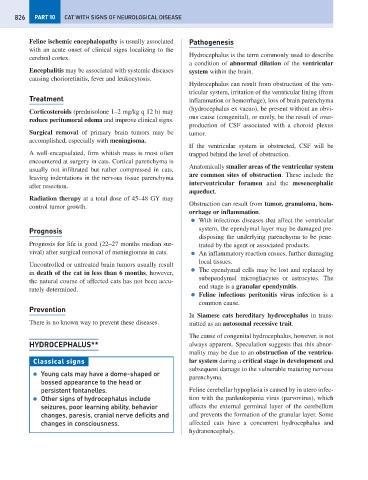Page 834 - Problem-Based Feline Medicine
P. 834
826 PART 10 CAT WITH SIGNS OF NEUROLOGICAL DISEASE
Feline ischemic encephalopathy is usually associated Pathogenesis
with an acute onset of clinical signs localizing to the
Hydrocephalus is the term commonly used to describe
cerebral cortex.
a condition of abnormal dilation of the ventricular
Encephalitis may be associated with systemic diseases system within the brain.
causing chorioretinitis, fever and leukocytosis.
Hydrocephalus can result from obstruction of the ven-
tricular system, irritation of the ventricular lining (from
Treatment inflammation or hemorrhage), loss of brain parenchyma
(hydrocephalus ex vacuo), be present without an obvi-
Corticosteroids (prednisolone 1–2 mg/kg q 12 h) may
ous cause (congenital), or rarely, be the result of over-
reduce peritumoral edema and improve clinical signs.
production of CSF associated with a choroid plexus
Surgical removal of primary brain tumors may be tumor.
accomplished, especially with meningioma.
If the ventricular system is obstructed, CSF will be
A well-encapsulated, firm whitish mass is most often trapped behind the level of obstruction.
encountered at surgery in cats. Cortical parenchyma is
Anatomically smaller areas of the ventricular system
usually not infiltrated but rather compressed in cats,
are common sites of obstruction. These include the
leaving indentations in the nervous tissue parenchyma
interventricular foramen and the mesencephalic
after resection.
aqueduct.
Radiation therapy at a total dose of 45–48 GY may
Obstruction can result from tumor, granuloma, hem-
control tumor growth.
orrhage or inflammation.
● With infectious diseases that affect the ventricular
Prognosis system, the ependymal layer may be damaged pre-
disposing the underlying parenchyma to be pene-
Prognosis for life is good (22–27 months median sur- trated by the agent or associated products.
vival) after surgical removal of meningiomas in cats. ● An inflammatory reaction ensues, further damaging
local tissues.
Uncontrolled or untreated brain tumors usually result
● The ependymal cells may be lost and replaced by
in death of the cat in less than 6 months, however,
subependymal microgliacytes or astrocytes. The
the natural course of affected cats has not been accu-
end stage is a granular ependymitis.
rately determined.
● Feline infectious peritonitis virus infection is a
common cause.
Prevention
In Siamese cats hereditary hydrocephalus in trans-
There is no known way to prevent these diseases. mitted as an autosomal recessive trait.
The cause of congenital hydrocephalus, however, is not
HYDROCEPHALUS** always apparent. Speculation suggests that this abnor-
mality may be due to an obstruction of the ventricu-
Classical signs lar system during a critical stage in development and
subsequent damage to the vulnerable maturing nervous
● Young cats may have a dome-shaped or
parenchyma.
bossed appearance to the head or
persistent fontanelles. Feline cerebellar hypoplasia is caused by in utero infec-
● Other signs of hydrocephalus include tion with the panleukopenia virus (parvovirus), which
seizures, poor learning ability, behavior affects the external germinal layer of the cerebellum
changes, paresis, cranial nerve deficits and and prevents the formation of the granular layer. Some
changes in consciousness. affected cats have a concurrent hydrocephalus and
hydranencephaly.

